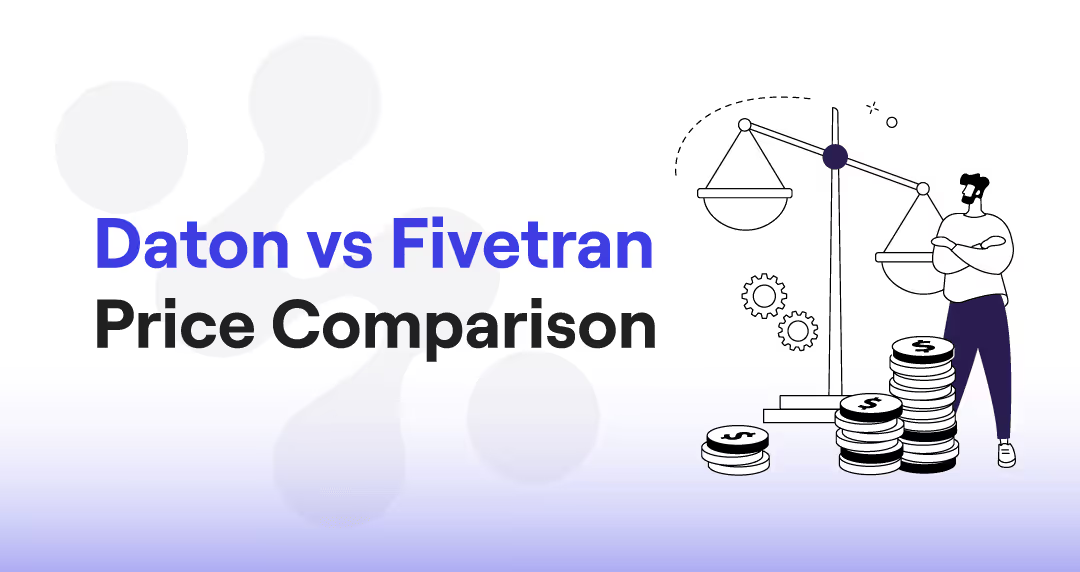A few years ago, if someone told you that TikTok will be much more than viral dances and trending challenges, it would have sounded crazy, right? But things have changed rapidly.
In 2023, TikTok Shop generated over $20 billion in gross merchandise value (GMV), which is a massive increase from the previous year (Bloomberg). Also, over 50% of TikTok users make purchases after seeing a product on the platform (Statista).
So, it's clear that TikTok Shop is having a huge impact on the eCommerce sector, and this growth highlights the importance of leveraging Tiktok Shop analytics to understand consumer behavior and optimize sales strategies.
TikTok’s native analytics provide only surface-level data. Getting granular insights like customer lifetime value (CLV), cross-channel attribution, or SKU-level sales trends requires error-free data integration with advanced analytics tools. That’s where tools like Daton come in. In this blog, we will talk in detail about Tiktok shop analytics and insights, and how to leverage the same to grow your business.
Why TikTok Shop Analytics Matter
For D2C brands, TikTok Shop offers an unprecedented opportunity to reach a massive, engaged audience. But this opportunity is also loaded with some level of complexity. Many brands struggle to make sense of their sales, marketing, and customer data.
Without proper TikTok shop data, they risk missing out on crucial insights that could drive conversions, optimize inventory, and improve ad performance. Therefore, it’s crucial for the eCommerce businesses to utilize the power of TikTok shop analytics. Here are some reasons why these analytics matter:
Insights into customer behavior and purchase patterns.
In today’s hyper-busy online world, every customer leaves a digital footprint. Therefore, understanding their behavior, what they browse, when they buy, and why they return is essential for optimizing sales. A McKinsey report found that companies leveraging customer insights see a 126% higher profit margin than those that don’t (McKinsey & Company).
TikTok Shop analytics help brands:
- Identify peak purchasing times.
- Understand what drives impulse purchases.
- Segment customers based on demographics, preferences, and buying patterns.
For example, beauty brand e.l.f. Cosmetics successfully tapped into TikTok trends by analyzing what products were driving conversations. Their viral C-B-D Lip Oil campaign leveraged insights from TikTok data, leading to a 71% increase in conversions from organic content (Glossy).
Tracking sales trends and performance of products
Tracking product performance is vital for maintaining a profitable catalog. Brands need to know which SKUs are selling fast, which ones are underperforming, and how seasonal trends impact demand. With TikTok shop analytics, brands can:
- Identify best-selling products and allocate more budget to their promotion.
- Forecast seasonal demand and prevent stockouts.
- Analyze refund and return rates to improve product offerings.
Enhancing marketing campaigns with real-time data
TikTok is the most engaging social platform, with an average user session of 10.85 minutes. But simply running ads isn’t enough. Brands need real-time data to optimize their TikTok Shop campaigns for maximum ROI. You can use TikTok Shop data also for the following reasons:
- Identifying high-converting ad creatives.
- Optimizing ad targeting based on purchase behavior.
- Tracking ROAS (Return on Ad Spend) and customer acquisition cost (CAC).
For instance, fashion brand Princess Polly increased their TikTok ad efficiency by 20% by leveraging data to retarget users who engaged with their shop but didn’t complete a purchase (Marketing Dive).
Optimizing operations based on data-driven insights
From improved customer satisfaction to reduced operating costs, inventory management when done correctly can lead to multiple benefits. If you want to achieve sustainability, profitability, and scalability in the world of eCommerce, you must optimize your inventory management. A Harvard Business Review study found that poor inventory management leads to over $1.1 trillion in lost sales annually (HBR).
By using TikTok Shop analytics, you can:
- Predict demand spikes and adjust inventory levels accordingly.
- Reduce overstocking costs by identifying slow-moving products.
- Automate restocking processes based on real-time sales data.
Common challenges in analyzing TikTok Shop data
Considering the fast-changing trends and high volume of data associated with TikTok shop, it becomes a huge challenge for the eCommerce businesses to analyze the data offered by this platform. Here are some key challenges related to TikTok shop data:
Fragmented data sources and manual data extraction
One of the biggest hurdles brands face these days is data fragmentation. Sales, customer interactions, and ad performance data are scattered across multiple dashboards. Manually extracting and consolidating this data is both time-consuming and error prone. Many businesses rely on spreadsheets, and this leads to:
- Hours wasted on manual data entry.
- Discrepancies between different data sources.
- Limited ability to generate real-time reports.
Limited insights from native TikTok analytics
We know that a lot of businesses still rely on TikTok Shop’s native analytics. But they provide basic performance metrics, lacking deep insights into customer behavior, product trends, and cross-channel attribution. If you’re looking for answers to questions like:
- “Which products bring in the highest lifetime value customers?”
- “How do TikTok Shop sales compare to other eCommerce channels?”
- “What’s the impact of influencer collaborations on sales?”
… you might hit roadblocks!
Without deeper analytics, businesses struggle to refine their marketing strategies and optimize their operations effectively.
Inconsistent data formats and reporting challenges
Data pulled from TikTok Shop is often in inconsistent formats, making it difficult to integrate with other platforms like Shopify, Google Analytics, or CRM tools. As a result of this kind of poor data structuring, you might end up facing issues like disorganized reporting dashboards, gaps in data accuracy and reliability, and difficulty in comparing TikTok Shop performance with other sales channels.
How Saras Daton simplifies TikTok Shop analytics
Saras Daton is an ETL (Extract, Transform, Load) tool designed to help eCommerce brands integrate TikTok Shop data effortlessly into their analytics stack. It automates data extraction, ensuring businesses have real-time insights without the hassle of manual reporting. Here are some key benefits that Saras Daton offers:
Accurate data extraction from TikTok Shop
Saras Daton directly connects to TikTok Shop’s backend, pulling:
- Sales data (orders, revenue, AOV, refunds).
- Marketing data (ad performance, campaign ROI, influencer conversions).
- Customer insights (new vs. returning customers, purchase frequency, demographics).
This ensures brands have a single source of truth for all their TikTok Shop data.
Automated data integration with popular destinations like BigQuery, Snowflake, and Redshift
One of Saras Daton’s key strengths is its ability to integrate TikTok Shop data with leading data warehouses such as Google BigQuery, Amazon Redshift, and Snowflake. By automating this process, it becomes easier to create custom dashboards, perform deep analysis, and make data-driven decisions in real time.
Maintaining data accuracy and consistency
It goes without saying that dad data leads to bad decisions. Saras Daton ensures data accuracy by implementing the following steps:
- Cleaning and structuring data before integration.
- Automating deduplication to prevent reporting errors.
- Ensuring consistency across all platforms to avoid mismatched metrics.
With Saras Daton, brands can confidently analyze their TikTok Shop data, knowing it’s accurate, up-to-date, and actionable.
Key metrics businesses can analyze with Saras Daton
If you’re looking to scale your TikTok shop, you should heavily focus on tracking the right metrics. This will help you put your efforts where it matters the most. You need to dive deep into key performance indicators (KPIs) that provide a complete picture of your sales, marketing, and customer behavior. This is where you can leverage the power of Saras Daton. It helps you track the following metrics:
Sales performance (revenue, orders, and AOV)
At the core of any eCommerce business is revenue. But just looking at overall revenue isn’t enough. You need to break it down into specific components to understand what’s driving your growth. Saras Daton allows brands to track:
- Total revenue: A clear picture of overall earnings from TikTok Shop.
- Order volume: How many transactions are happening daily, weekly, or monthly.
- Average order value (AOV): The average amount customers spend per purchase.
For example, CeraVe, a skincare brand that has gone viral on TikTok multiple times, saw a 300% increase in sales after TikTok users started raving about their products (Business Insider). By tracking how each viral moment impacted their revenue and AOV, CeraVe optimized their inventory and marketing spend to capitalize on these trends.
Marketing ROI from TikTok campaigns
Running TikTok campaigns without measuring their effectiveness is like throwing darts in the dark. Brands need to know what’s working, what’s not, and where their ad dollars are best spent. Saras Daton helps brand track these key metrics:
- Return on ad spend (ROAS): How much revenue is generated for every dollar spent on ads.
- Conversion rates: What percentage of TikTok viewers are actually making a purchase.
- Customer acquisition cost (CAC): How much it costs to gain a new customer from TikTok ads.
Customer behavior (new vs. returning customers, demographics)
Not all customers are created equal. Some buy once and never return, while others become loyal brand advocates. Understanding customer behavior helps you tailor your marketing efforts. With Saras Daton, you get insights into:
- New vs. returning customer ratio: i.e., how many first-time buyers come back for repeat purchases.
- Demographics: Age, location, and other details that help with audience segmentation.
- Customer lifetime value (CLV): How much revenue an average customer generates over time.
A great example is Glossier, a beauty brand that built a cult following by understanding its audience. They used TikTok insights to create hyper-targeted campaigns, leading to a massive increase in repeat customers (Forbes).
Product performance and inventory trends
We all know that product demand on TikTok is unpredictable. A single viral video can wipe out your entire inventory overnight. To keep your business prepared for this kind of situation, you need real-time product performance insights. With Saras Daton you can track your best-selling products to identify which SKUs are driving the most revenue, slow-moving inventory to prevent overstocking and markdown losses, and return rates too.
Conclusion
The rise of TikTok Shop has definitely opened a new box of opportunities for eCommerce brands. With over one billion monthly active users and a growing culture of social commerce, businesses that leverage TikTok Shop analytics will gain a competitive edge.
However, harnessing the power of TikTok Shop data isn’t easy. From fragmented reporting to limited native analytics, brands face multiple challenges in unlocking valuable insights. That’s why you need a powerful and reliable tool like Saras Daton to make sense of the TikTok shop data and scale your sales with data-driven decision-making. Learn more about how Saras Daton can transform your TikTok Shop analytics today!








.png)






.avif)

.avif)
.avif)
.avif)
.avif)
%20(1).avif)
.avif)
%20(1).avif)
%20(1).avif)




.avif)











































.avif)






.avif)











.jpg)

